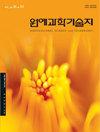Effects of Starfish and Lacquer Tree By-product Fertilizer on Growth of Tomato Plants
IF 0.8
4区 农林科学
Q3 HORTICULTURE
Korean Journal of Horticultural Science & Technology
Pub Date : 2023-08-31
DOI:10.7235/hort.20230034
引用次数: 0
Abstract
This study was conducted for investigate the effect of Starfish and Lacquer Tree by-product Fertilizer on Growth of Tomato Plants. When starfish and lacquer fertilizers were applied to tomatoes, the results of the root survival rate after transplanting tomatoes showed 93% root survival rate both in the control group and 10% starfish treatment, whereas 100% survival rate from 10% lacquer treatment, and 5% starfish with 5% lacquer mix. After transplanting, plant height was 173.0cm in10% lacquer treatment, and 191.13cm in 5% starfish with 5% lacquer mix were significantly higher than those of 144.5cm in 10% starfish single treatment. Chlorophyll content was significantly higher at 1.90 mg/g in the 5% mixed treatment group of starfish and lacquer compared to those of 1.47 mg/g in control. Among dry matter, 10% of starfish and 10% of lacquer treatments showed 13.69 g, which was 1.73 times higher compared to 7.92 g in control. Calcium content was significantly higher at 14.68 mg/L in the 5% mixture of starfish and lacquer compared to 11.41 mg/L in control. The higher the calcium content and hardness during storage, the lower the blossom-end rot incidence. The hardness of the fruit was the best in the mixed treatment of 5% starfish and 5% lacquer, and the shelf life was maintained over 60% even on December 8th. The highest tomato weight and marketable yield showed in the mixed fertilizer of 5% starfish and 5% lacquer. Therefore, the mixed 5% starfish with 5% lacquer tree by-product fertilizer can be used to promote the production and to improve the quality of tomato fruits preferred in markets海星和漆树副肥对番茄植株生长的影响
本试验研究了海星和漆树副肥对番茄植株生长的影响。在番茄上施用海星和漆肥时,番茄移栽后根系成活率结果显示,对照组和10%海星处理的根系成活率均为93%,而10%漆肥处理和5%海星与5%漆肥混合处理的根系成活率均为100%。移栽后,5%海星和5%海星的株高分别为173.0cm和191.13cm,显著高于10%海星单独处理的144.5cm。5%海星漆混合处理组叶绿素含量为1.90 mg/g显著高于对照组的1.47 mg/g。干物质中,10%的海星处理和10%的漆处理为13.69 g,是对照组7.92 g的1.73倍。5%海星漆混合物钙含量为14.68 mg/L,显著高于对照11.41 mg/L。贮藏过程中钙含量和硬度越高,花端腐病发生率越低。5%海星和5%漆混合处理的果实硬度最好,即使在12月8日也保持了60%以上的保质期。5%海星与5%漆混合施用的番茄重和商品量最高。因此,5%海星与5%漆树副肥混合施用可促进番茄产量,提高市场首选番茄果实的品质
本文章由计算机程序翻译,如有差异,请以英文原文为准。
求助全文
约1分钟内获得全文
求助全文
来源期刊
CiteScore
2.00
自引率
0.00%
发文量
0
审稿时长
1 months
期刊介绍:
Horticultural Science and Technology (abbr. Hortic. Sci. Technol., herein ‘HST’; ISSN, 1226-8763), one of the two official journals of the Korean Society for Horticultural Science (KSHS), was launched in 1998 to provides scientific and professional publication on technology and sciences of horticultural area. As an international journal, HST is published in English and Korean, bimonthly on the last day of even number months, and indexed in ‘SCIE’, ‘SCOPUS’ and ‘CABI’. The HST is devoted for the publication of technical and academic papers and review articles on such arears as cultivation physiology, protected horticulture, postharvest technology, genetics and breeding, tissue culture and biotechnology, and other related to vegetables, fruit, ornamental, and herbal plants.

 求助内容:
求助内容: 应助结果提醒方式:
应助结果提醒方式:


